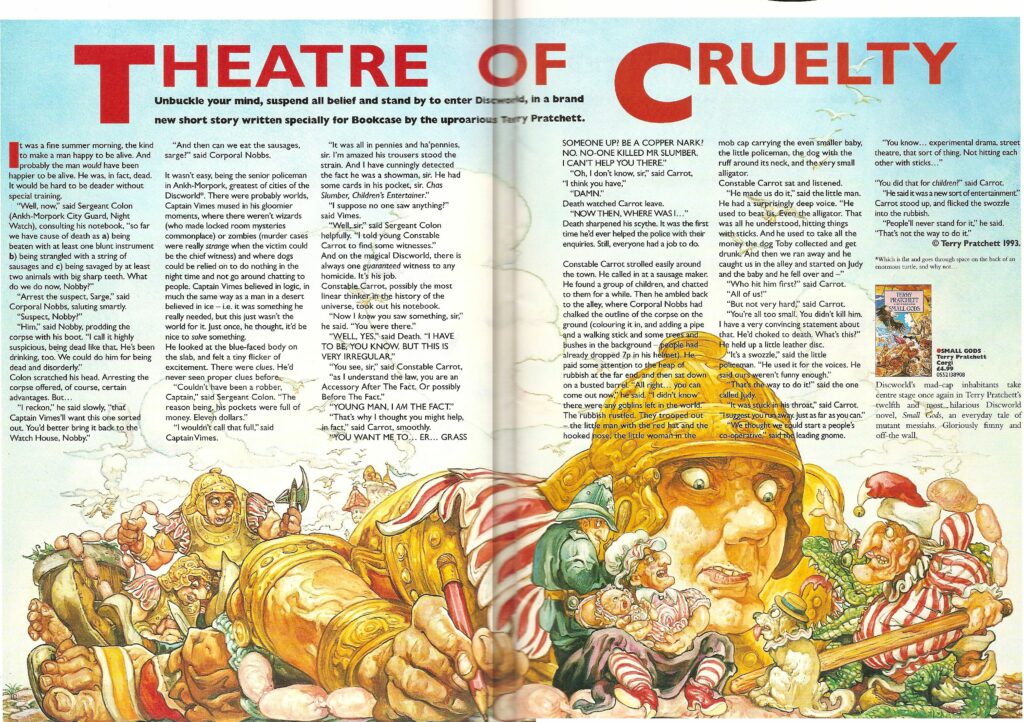#Pratchat66 – Ol’ No Eyes Is Back
Returning guest, author Amie Kaufman heads back to the Chalk with Liz and Ben to face the rough music in a bumper-size discussion of the penultimate Tiffany Aching book, 2010’s I Shall Wear Midnight.
Tiffany Aching, nearly sixteen, is no longer an apprentice. Now two years under the witch’s hat, she cares for those as can’t care for themselves, and deals with the harsh realities of rural life. But all is not well in the Chalk: the unending need for its only witch is pushing Tiffany to the edge, and an act of violence – and its consequences – test her limits. Roland, the Baron’s son, is engaged – but not to Tiffany. While he’s away, the old Baron dies, and Tiffany must fetch him home to take his place. And on top of all that, something is stirring: something old and evil that stirs up old prejudices and fears about witches – and is aiming them directly at Tiffany Aching…
Content note: this episode contains discussion of (fictional) intimate partner and family violence, miscarriage and suicide.
If you or anyone you know needs help, use the Wikipedia list of crisis lines to find one local to you.
Nearly three years after she danced the Dark Morris and kissed the Wintersmith, we rejoin Tiffany Aching, who is discovering that even fixing her mistakes can have consequences. But is this really a book for younger readers – or even young adults – when it includes some of the heaviest stuff of any Discworld novel? Does it all hang together, or are there a few ideas fighting each other in this plot? Who knew what and when about the Cunning Man, and is he Pratchett’s creepiest villain yet? What spill words do you not say when you’re listening to the show? Join in the conversation using the hashtag #Pratchat66 on social media!
Podcast: Play in new window | Download (Duration: 2:40:30 — 74.0MB)
Returning guest Amie Kaufman is the author of (so far) twenty novels for middle grade and young adult audiences, including the Illuminae Files and Aurora Cycle sci-fi trilogies with Jay Kristoff; the Elementals, Starbound and Unearthed series with Meagan Spooner, and the World Between Blinks books with Ryan Graudin. For Pratchett fans she recommends her upcoming YA fantasy novel Isles of the Gods, launching in May 2023. As mentioned in the episode, Amie also produces two podcasts about writing: Amie Kaufman on Writing, a 10-minute masterclass on writing techniques, and Pub Dates, in which she and co-writer Meagan Spooner take you behind the scenes on writing and publishing a novel, and what comes after. For more of Amie’s exploits visit amiekaufman.com or sign up for her Substack newsletter Finding North.
As usual, you can find notes and errata for this episode on our web site.
Catch Liz in person when she’s one of the speakers for the Sci-Fight science comedy debate “Should we fear AI?” on Thursday, 13 April 2023 at Howler in Melbourne! It’s hosted by previous guest Alanta Colley and features a great line-up of comedians, writers and scientists. Get all the details and book tickets vis moshtix.
Next month, now that we’ve met all the characters who’ll appear in it, we’ll be playing and discussing the 2013 board game The Witches: A Discworld Game, designed by Martin Wallace! Send us your questions using the hashtag #Pratchat67, and if you’re a subscriber, watch out for an unboxing video via our Ko-Fi page soon. And while our plans for #Pratchat68 in June aren’t quite fixed yet, here’s an earlier than usual heads up that in July we’ll be discussing the fourth Long Earth novel, The Long Utopia, with returning guest Deanne Sheldon-Collins. Those books are long, so you might want to get started now! Send in your questions for that one using the hashtag #Pratchat69 – or drop us an email at chat@pratchatpodcast.com.
Want to help us get to the end of our six(ish) year mission and read every Pratchett book – and more? You can support us with a tip, or a subscription for as little as $2 a month, and that’s cuttin’ our own throats! See our Support Us page for details.

